Propagating wandering jew plants is very easy and makes a cost-effective way to expand your collection.
In this post, I’m going to describe how to multiply Tradescantia (also known as inch plant or wandering dude) by rooting the cuttings in water or soil.
I’ll provide step-by-step instructions and a list of all the essential supplies you’ll need. I’ll also explain the best time to propagate them, and share my tips for success.
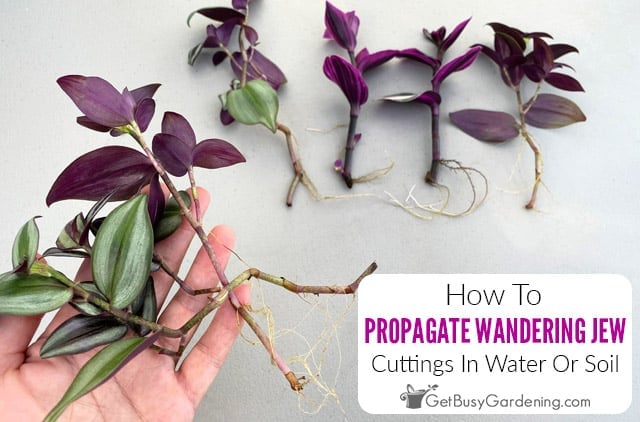
Wandering Jew Propagation Methods
There are two methods you can use to propagate a wandering jew – you can divide it, or root the stem cuttings in water or soil.
Rooting the stems is the easiest option and the method I’ll focus on in this guide, but below I’ll introduce you to both.
By Division
Division involves separating a mature wandering dude and its roots into several smaller sections, then planting each division into a new container.
This is the quickest way to get a sizable plant, but also the most labor intensive, since you have to pull the plant out of the pot or dig it up.
The vines are also tend to become intertwined on a mature plant and they are very fragile, so it can be difficult to separate them without breaking off several of them in the process.
From Cuttings
Propagating wandering jews from cuttings is the most common method and the one I recommend. This is because it is the easiest way to expand one plant into several.
You simply take stem cuttings that contain leaves and nodes from your mature plant, then root them in soil or water.
Roots quickly develop from the nodes, and new leaves begin growing after a month or so.
While it may also be possible to propagate a wandering jew from a single leaf rather than a stem, it’s not a method I recommend. Even if a leaf forms roots, it likely will never grow into a full-sized plant.
When To Propagate Tradescantia
The best time to propagate wandering jew cuttings is in the spring or summer when the plant is actively growing.
The warmer temperatures and humidity at this time of year are helpful, too, improving the chances they’ll root quickly and successfully.
Propagating Wandering Jew From Cuttings
Rooting stems is the easiest and most popular way to propagate Tradescantia, so I’m going to walk you through the process step by step.
First, though, let’s look at how to take and prepare your cuttings for the best results.
How To Take Wandering Jew Cuttings
Using a clean, sterilized pair of precision pruners or micro snips, take a cutting that’s about 4 inches long from anywhere on the stem. Make your cut just below a leaf node, at a 45° angle.
Leaf nodes on wandering jew plants are around an inch apart, which is why it is also known as an inch plant.
Roots develop from these nodes, and a 4-inch cutting should contain at least two, along with several leaves.
I recommend wearing gloves while handling the stem, as the sap may irritate your skin.
Related Post: How To Prune A Wandering Jew Plant (Tradescantia)

Preparing Tradescantia Cuttings For Propagation
To prepare your wandering dude cuttings for propagation, remove any leaves from the lower section to expose a few inches of the stem. You can do this by snipping or pinching them off.
Don’t remove all of the leaves, be sure to keep a on the top, because they need them to survive.
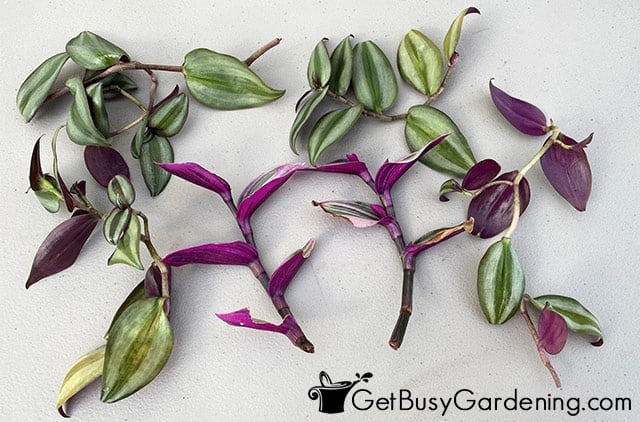
Tips For Propagating Tradescantia In Water Or Soil
Once you’ve prepared your wandering jew cuttings for propagation, you can either root them in water or soil.
Do this as quickly as possible so that they don’t dry out or shrivel, as this might stop them from rooting.
Propagating Wandering Jew In Water
After preparing the stem, submerge them in a vase of tepid water deep enough so all of the exposed nodes are covered. I like to use a clear vase for this because it’s fun to watch the roots develop.
Keep the vase in a warm, bright place and ensure the water remains topped off and clean. Then watch for the roots to form. Once they’re 3 to 4 inches long, pot them up.
The disadvantage to this method is that the roots tend to be thinner and weaker than those propagated in soil.
It can also be difficult for your plant to make the transition back to soil if it stays in water for too long. This is why it’s important to pot it up as soon as the roots are long enough.
Rooting Wandering Jew Cuttings In Soil
This method takes a bit more time and effort, but the cuttings will develop stronger, more robust roots in soil than they do in water. This gives them a better chance of survival once they’re potted up.
For the best results dust the stems with rooting hormone, then place them at least 3-4 inches deep into lightweight, moistened growing medium or a soilless mix. Gently press the medium around them so that they can stand on their own.
Tent a plastic bag over the top, or place the lid on your propagation chamber if you are using one. Move the container to a warm spot with plenty of indirect light and keep the soil moist.
How Long Does It Take Tradescantia Cuttings To Root?
Wandering jew cuttings root quickly. As long as the conditions are right, roots will begin forming within 2 to 7 days.
If you put them in a clear vase of water you can easily see when they are ready to be potted up. This is usually after about two weeks.
You can tell they’re rooted in soil when new leaves begin forming on top. Alternatively, you can gently tug the cuttings – if they have roots, they shouldn’t move.
Why Won’t My Wandering Jew Propagate?
There are several factors that can stop your cuttings from rooting successfully.
Warmth is important, so consider using a heat mat if your house is very cool. Plenty of indirect light is essential, too, so use a grow light if your home is too dark.
Check that the soil is evenly moist, or that the nodes are fully submerged if you’re propagating them in water.
Also, consider the time of year. If you’re trying to propagate your wandering dude during the cooler months, it will be more difficult.
Related Post: Why Does My Wandering Jew Have Brown Leaves & How To Fix It
How To Care For Wandering Jew Cuttings
Your wandering jew cuttings will need adequate moisture to survive, and plenty of warmth and light to form roots.
If you are propagating them in water, this means ensuring the roots remain submerged at all times. If you’re using soil, then make sure it stays evenly moist.
Keep them in a warm, bright place, but avoid direct sunlight, as this can burn the leaves or cook if it gets too hot under the plastic.
Potting Up Rooted Tradescantia Cuttings
Once your Tradescantia cuttings have 3-4” long roots, it’s time to pot them up.
Fill a clean pot with good quality, pre-moistened general potting soil. Then plant the stems at the same depth they were in the water or growing medium, ensuring the roots are fully covered.
Gently press the soil around them and water lightly. Then place them in a warm spot with plenty of bright but indirect light.
Once you have your new babies all potted up, you can care for them like you would any other wandering jew plant.
FAQs
The following are some of the most commonly asked questions about propagating wandering jew plants. If yours isn’t listed here, please ask in the comments section below.
Can you propagate wandering jew leaves?
You may be able to propagate wandering jew leaves, but I don’t recommend it. It can be difficult to grow a healthy, full-sized inch plant from a single leaf, and it most likely would not get very large.
Where is the growth node on a wandering jew?
The growth nodes on wandering jew plants are located along the stem or just below a set of leaves, and look like small bumps. Some may even have tiny root nubs already forming.
Can you grow wandering jew from cuttings?
Yes, you can easily grow wandering jew from cuttings by rooting them either in water or soil, even if you’re a beginner.
Where do you cut wandering jew to propagate?
To propagate a wandering jew, cut them anywhere along the stem, just below a leaf node and at about a 45° angle. Make sure the stems are 3-4″ long for the best success.
Can you propagate wandering jew directly in soil?
Yes, you can propagate wandering jew directly in soil, and this is my preferred method. It gives the cuttings strong, robust roots, and improves their chances of survival once potted up. Use a propagation chamber or tent plastic over the top to speed up the process.
Can you root wandering jew cuttings in water?
Yes, you can root wandering jew cuttings in water. It’s a quick and simple method that makes it easy to monitor the growth of the roots. I like to use a clear vase for this so I can watch as the roots form.
Do you want to learn how to multiply all of your plants? Then my Plant Propagation eBook is for you! It will show all you need to know to get as many new plants as you want from your existing ones. Grab your copy today!
More About Plant Propagation
- Propagating Peperomia In Water Or Soil
- Propagating ZZ Plants From Cuttings Or Division
- Propagating String Of Hearts (Rosary Vine) From Cuttings Or Division
- How To Propagate Lipstick Plant (Aeschynanthus) In Water Or Soil
- How To Propagate Begonias In Water Or Soil
Share your tips for how to propagate wandering jew in the comments section below.
Step By Step Instructions
How To Propagate Wandering Jew (Tradescantia)

Learn how to propagate your wandering jew plant in water. Discover my tips for rooting them successfully, including how to prepare your cuttings, and how to tell when it’s time to pot them up.
Materials
- Mature wandering jew plant
- Small vase
- Tepid water
- Fresh potting soil
- 4” pot with drainage holes
Instructions
- Take the cuttings - Use precision pruners or micro-snips to take 4 inch cuttings from anywhere on the stems. Cut just beneath a leaf node at about a 45° angle.

- Prepare the stems - Pinch or snip off the lower leaves to expose 2-3 inches of the stem and at least 1 node.
- Submerge the nodes - Fill the vase with tepid water and place the cuttings inside until the nodes are submerged.

- Place somewhere warm and bright - Don’t expose the cuttings to direct sunlight, as this can burn the leaves. You can use a grow light if necessary.

- Monitor water level and cleanliness - Make sure to top off the water as it evaporates. If it looks murky at any point, rinse out the vase and refill it with fresh, tepid water.
- Watch for roots to form - Roots should begin to form in 2-7 days. Once they’re 3 to 4 inches long, it’s time to pot up your cuttings.

- Pot up the rooted cuttings - Fill a 4” pot with general purpose potting soil, Plant your cuttings so the stems are buried at the same depth as they were in the water. Press the soil around them, water them lightly, and return to a bright, warm location.

Notes
- The sap from a wandering jew can irritate your skin, so you might want to wear gloves while taking cuttings.
- Be sure to place the cuttings into the water as quickly as you can so they don’t have a chance to dry out, or they may not root.
- Once your cuttings have 3-4” long roots, pot them into fresh soil. Leaving them in water for too long can weaken the roots and cause severe transplant shock.
- If you prefer to propagate your cuttings in soil rather than water, be sure to dust the stems with rooting hormone and use a lightweight medium. The soil method may take longer, but it is more likely to result in hardier roots that transplant successfully.


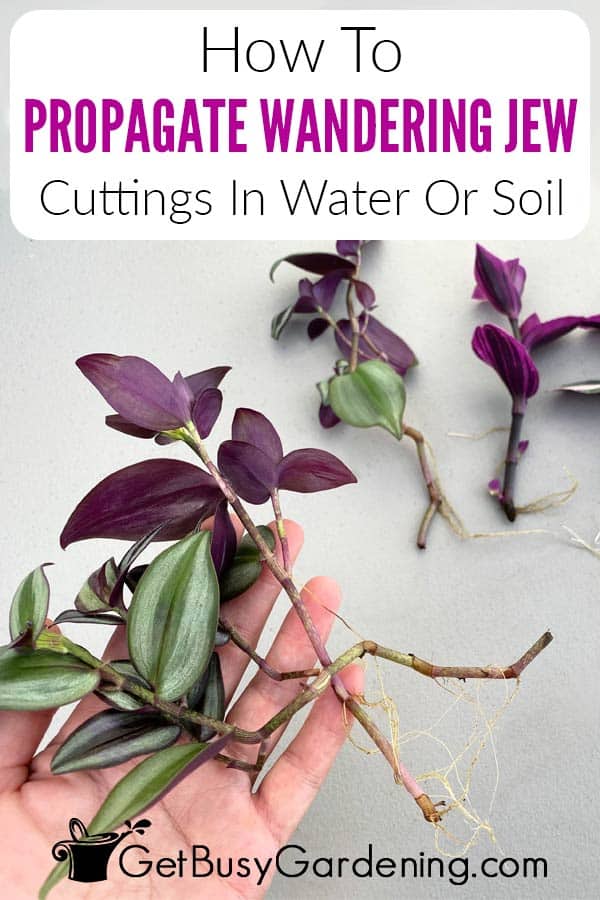

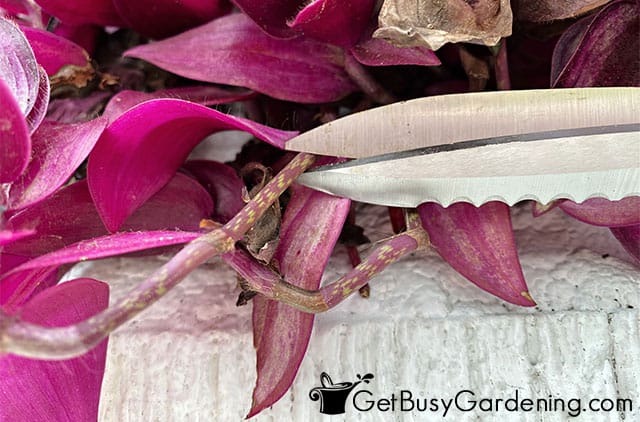
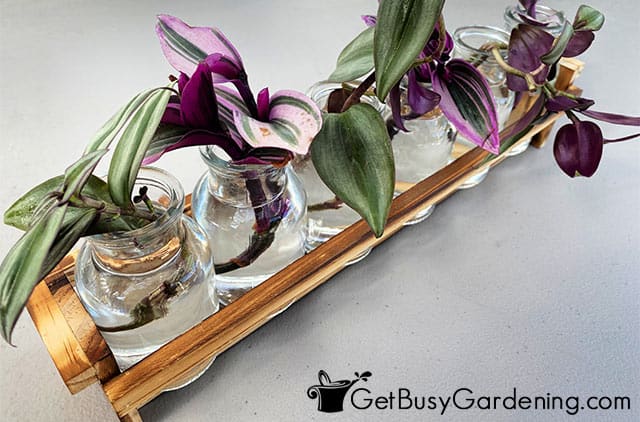



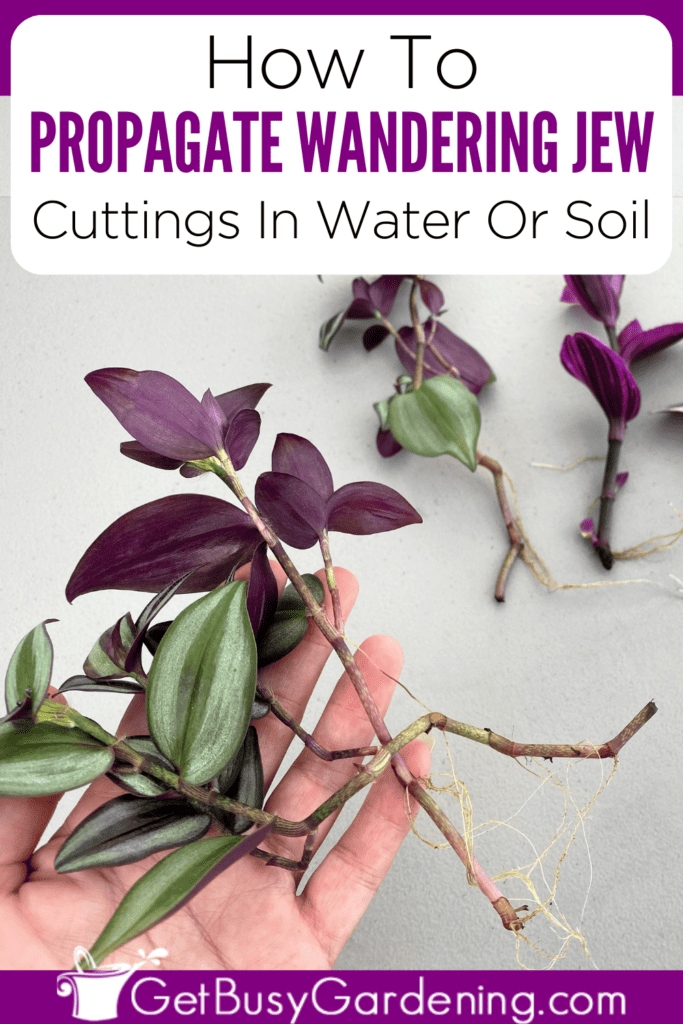

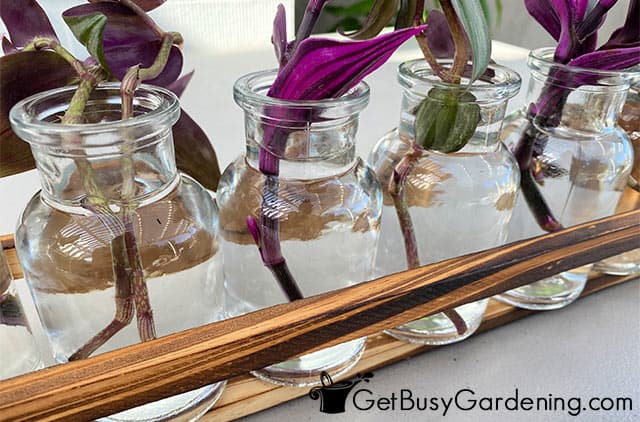
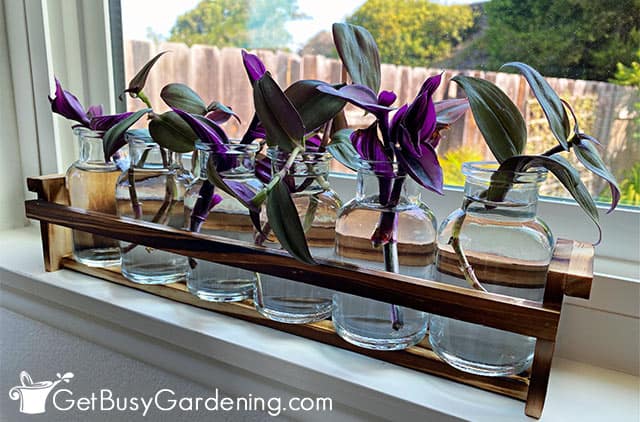
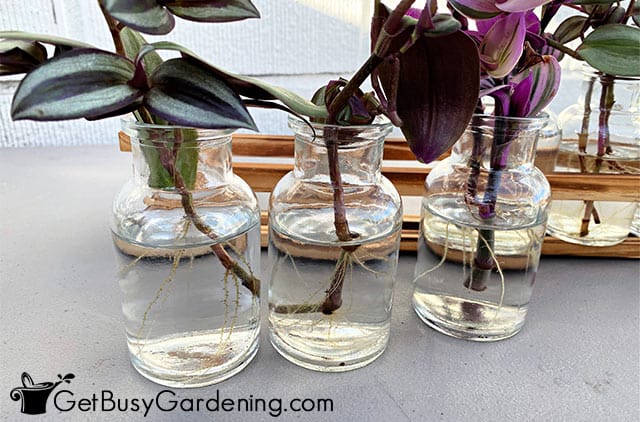
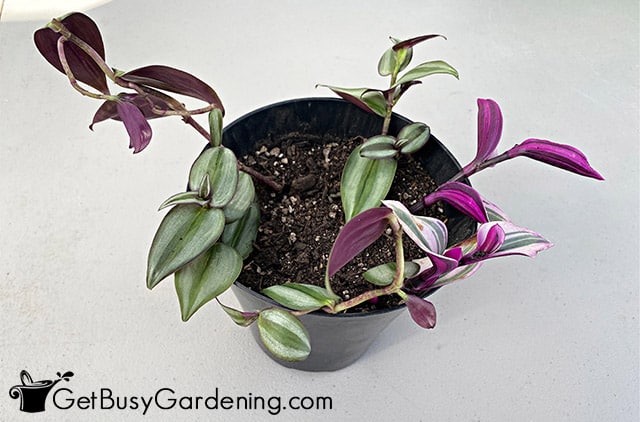

Charles N. says
I have a weird situation. I planted a cutting last October in water and it began its slow growth during the winter. It’s now over 7 months and I have six new leaves. BUT I still don’t have any roots coming out. Not even 1mm! Shall I cut the stem at the base hoping for roots to come out? Please advise.
Amy Andrychowicz says
It’s common for them to go into a semi-dormant state in the winter and, if it’s too cold, they won’t really do anything. Now that the weather is warming up, your tradescantia cutting should start to grow roots. Give it plenty of bright light and warmth, and it will come alive faster.
Abbie Bass says
what is the best meium to plant rooted Trendecantia cuttings??
Amy Andrychowicz says
A lightweight soilless medium, like a seed starting mix, is the best option for rooting Tradescantia cuttings.